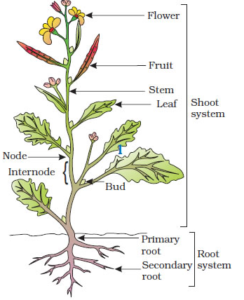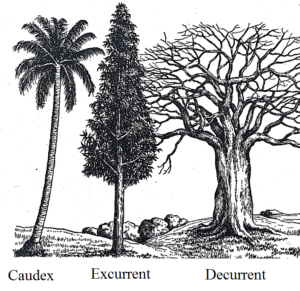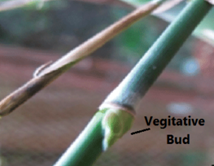Science > Biology > Botany> Morphology of Plants > The Stem and Buds
The body of a typical flowering plant can be divided into the underground root system and aerial shoot system. The shoot system is heterogeneous. The shoot system (stem) is an aerial and erect part of the plant body that grows upwards. It is usually above the soil and develops from the plumule of the embryo of a germinating seed. It consists of stem, branches, leaves, flowers, fruits, and seeds.

The Stem:
The stem is negatively geotropic (moves above the soil), negatively hydrotropic (moves away from the water) and positively phototropic (moves towards the light). Branches arise from axillary buds present in the axil of leaves. Each axillary bud is a small, compact, underdeveloped shoot covered with a large number of overlapping leaf primordia. Internodes of this bud enlarge and develop into a branch. Therefore the development of branches is exogenous (exo = outside).
Characteristics of Stem:
- Stem arises as a prolongation of plumule (one end of an embryo).
- The shoot system is heterogeneous and consists of stem, branches, leaves, and flowers.
- The stem is negatively geotropic (moves above the soil), negatively hydrotropic (moves away from the water) and positively phototropic (moves towards the light).
- The stem bears nodes and internodes. The regions of the stem where leaves are born are called nodes while internodes are the portions between two nodes.
- The stem bears vegetative buds which could be terminal (apical bud) for the plant to grow upwards or axillary (bud in the axil of the leaf) which give rise to lateral branches. The stem bears floral buds (terminal or axillary) that grow into flowers
- The young stem is green in colour and thus it is photosynthetic. The mature stem is generally green when young and later often become woody and dark brown.
- Lateral branches of the stem are exogenous in origin.
Functions of the Stem:
Primary functions of the stem are
- To support and orient the leaves in a manner that they are exposed to maximum sunlight and for efficient gaseous exchange during photosynthesis and respiration.
- To conduct water and minerals from roots to leaves and manufactured food from leaves to different parts of the plant.
- To bear flowers and fruits
Some stems perform the function of storage of food, support, protection and vegetative propagation. The secondary functions of the stem are
- Storage: Some stems store food and water in some plants e.g. potato
- Perennation: The underground stems help tide over the unfavourable growing periods e.g. ginger, turmeric.
- Vegetative propagation: e.g. rose, and sugarcane the stem can be used for vegetative propagation.
- Photosynthesis: In xerophytes (desert plants) the leaves are reduced to thorn, the stem possessing chlorophyll takes up the function of photosynthesis. e.g.Opuntia
- Protection: In some plants, the axillary bud modifies into the thorn and protects the plants from grazing animals e.g. citrus, Duranta.
- Support, Climbing and Clinging: Tendrils or hooks are modified branches or buds. They coil around
the support and help the plant to climb e.g. grapevine.
Types of Stem:
The stem may be
- aerial (erect, rigid, strong and upright as in herbs, shrubs, and trees) or
- subaerial (weak, unable to stay upright and trail on the ground as creepers or climb up as climbers) or
- underground (buried in soil and produces aerial branches under favourable conditions only
Branching of Stem:
There are three main forms of branching.
- Excurrent: the main trunk goes the entire height of the tree, with branches forming patterns; e.g. Evergreens, pinus.
- Decurrent: The main trunk continues up about halfway, then splits into more than one main branch; eg. fruit trees.
- Columnar or Coudex: The main trunk continues the full height of the tree, with the branches forming only at the top; eg. Palm trees, coconut tree.

Lateral Branching:
Branching is racemose or cymose according as the lateral buds are less vigorous or more vigorous than the apical bud.
Racemose Branching:
In racemose or monopodial branching the apical bud of the plant grows indefinitely giving rise to a straight stem axis or podium on which the lateral buds grow in acropetal succession, i.e. older branches are borne near the base and younger branches towards the apex.

This type of branching is the commonest among young Phanerogams. as the plant grows older, the apical bud often gets lost and some side branches become very strong so that the plant loses its monopodial character.
Instead of there being a single leaf at each node there be a whorl of leaves, the branches at each node will also be whorled. Then it is called whorled racemose.

Types of Buds:
Small lateral or terminal protuberance on the stem of a vascular plant that may develop into a flower, leaf, or shoot is called bud. Buds arise from meristem tissues. Flower buds are modified leaves. Buds are classified as follows:
Types of Buds on the Basis of Their Function:
Vegetative buds:
They contain embryonic leaves or shoots. They grow into new branches and shoots.

Floral buds:
They contain embryonic flowers. They grow into flowers. They are also referred as reproductive buds.

Mixed buds:
They contain both embryonic leaves and flowers. They may gro into vegetative parts like soot or leaf or into a flower part.

Tendrillar buds:
They grow into tendrils.

Types of Buds on the Basis of Its Position:
On the basis of the position of the buds, they are classified as terminal or apical buds and lateral buds.

Terminal or apical buds:
They develop at the apex of the main stem or branch. e,g, cabbage is a large apical bud

Lateral buds:
They develop into lateral branches or flowers. They are further classified as axillary buds, accessory buds, and sub-petiolar buds. Axillary buds are lateral buds that arise in the axil of the leaf, e.g. Sunflower, Citrus, Rose. Accessory buds are more than one bud that arises in the axil of a single leaf. e.g. Cucurbita, Luffa, Brinjal, Chilly, Bougainvillaea. Subpetiolar buds are axillary buds those are covered by a sheathing leaf base and appear to arise from the leaf base. As they remain dormant for a quite long time they are also referred as dormant buds. When they gro they are referred as sprouting buds. e.g. Dalbergia sissoo (Shisam) and Mulberry.

Bud Scales:
In some plants, buds are covered by overlapping scales, these scales are called bud scales. These bud scales are tough and may be modified leaves, leaf bases, petioles or stipules. e.g. Jackfruit, Ficus, and Magnolia.

Winter Buds:
In extremely cold regions plants bear specially protected buds called winter buds. During cold period leaves fall but the winter buds remain intact. During spring the bud opens with developing young leaves. e.g. Cauliflower, Cabbage.

Adventitious Buds:
They arise at a position other than their normal position. Epiphyllous or foliar buds arise on leaves. e.g. Begonia, Bryophyllum, etc. Cauline buds arise from the cut or pruned end of branches. e.g. Sweet potato, Coffee, Aegle, etc. Radical buds develop on the roots. e.g. Sweet potato, Dahlia, Dalbergia.

Turions Buds:
A turion bud is a resistant plant bud that is found in certain aquatic plants and can allow the plant to survive winter in the vegetative state. e.g. Ultricularia, Potamogeton.
